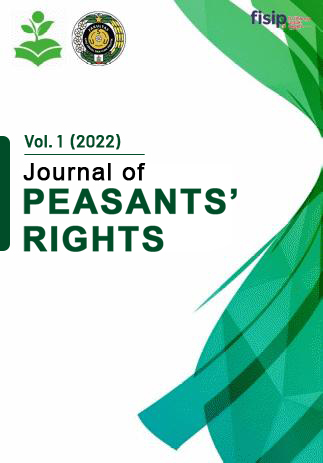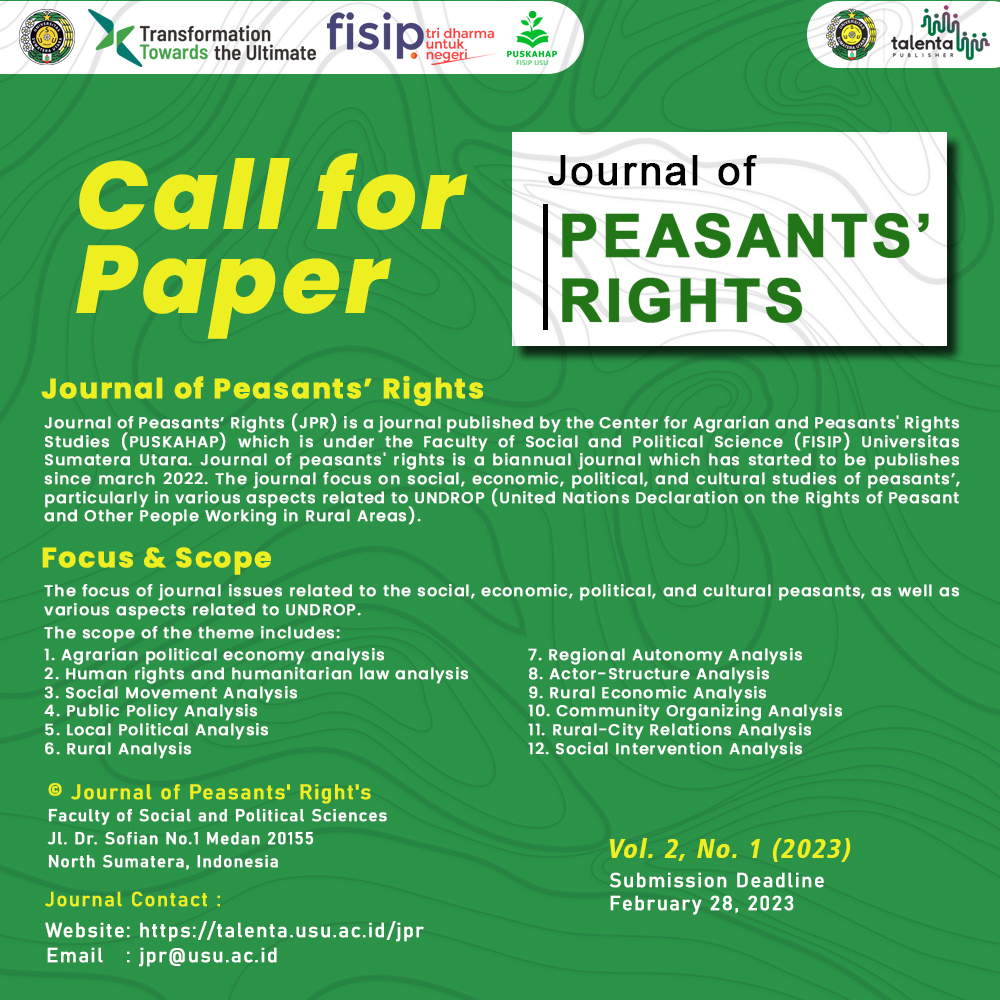The Existence of Indonesian Peasants in Three Eras: Dutch Colonialism, Japanese Colonialism, and The Independence
DOI:
https://doi.org/10.32734/jpr.v2i2.14141Keywords:
Peasant, Ducth Colonialism, Japan Colonialism, Independence EraAbstract
This article discusses the existence of peasants during three eras with different powers. During the Dutch and the Japanese colonialism, it can be said that peasant is a profession that must be avoided because it will become an object of exploitation by those in power. During Dutch rule in Indonesia, the policies that exploited peasants were ‘culturstelseel’ (the forced planting system) and the 1870 Agrarian Law. These two policies made peasants even more impoverished, the lands that formerly owned peasants were forcibly taken away to plant commodities that were in demand on the world market and the profits went into their pockets ruler. During the Japanese colonialism, an obligation to produce rice made peasants increasingly tormented because they had to pursue predetermined targets. During The independence, the peasants were embraced by political parties until they were transformed into mass organizations. Although there has been some progress in the national agrarian political agenda, differences in ideology and interests have resulted in conflicts and struggles between peasant mass organizations, and even with civil society.
Downloads
References
Agustono, Budi. 1995. Kebijakan Perburuhan di Sumatera Timur. Medan : Yayasan Akatiga.
Alfian, Ibrahim. 2016. Perang Aceh: Perang di Jalan Allah. Yogyakarta: Ombak.
Anggraini, G. (2016). Islam Dan Agraria. Telaah Normatif Dan Historis Perjuangan Islam Dalam Merombak Ketidakadilan Agraria. STPN Press.
Benda, Harry J. (Aug 2015). The Beginnings of the Japanese Occupation of Java the Far Eastern Quarterly. Vol. 15. Duke: Duke University Press.
Berger, L. Peter. 1957. Sedjarah Sosiologis-Ekonomis Indonesia. Jakarta: Balai Pustaka.
Breman, Jan. (2015). Mobilizing Labour for the Global Coffee Market: Profits from an Unfree Work Regime in Colonial Java. Amsterdam: Brill.
Harian Rakyat, 15 Agustus 1955.
Hasibuan, J. A., Saragih, M. W., Hasibuan, Y. S., & Anshari, A. (2023). Journal of Peasants'
Rights. Journal of Peasants’ Right's, 2(1), 9-16.
Historia, 2022.
Ikhsan, Edy. 2012. Konflik Tanah Ulayat dan Pluralisme Hukum: Hilangnya Ruang Hidup Orang Melayu Deli. Jakarta: YOI.
Indisch Courant, 22 Agustus 1951.
Kahin, George Mc Turnan. 2013. Nasionalisme dan Revolusi Indonesia. Jakarta: Komunitas Bambu.
Koran Sumatera, 16 Agustus 1951.
Koran Sumatera, 25 Agustus 1953.
Koran Sumatera, 31 Mei 1955.
Koyagi, Mikiya. (2013) . The Haji by Japanese Muslims in the Interwar Period: Japan’s Pan Asianism and Economic Interest in the Islamic World. “Journal of World Historyâ€. Vol. 24. No. 4. Hawai: University of Hawai.
Kuntowijoyo. 2014. Metodologi Sejarah Edisi kedua, Yogyakarta: Tiara Wacana.
Kurasawa, Aiko. (Okt 2016). Propaganda Media on Java under the Japanese 1942-1945. Cornell: Cornell University Press.
Leirissa, dkk. 2017. Sejarah Perekonomian Indonesia. Yogyakarta: Ombak.
Luthfi, A. N. (2017). Sejarah dan Revitalisasi Perjuangan Pertanian Nahdlatul Ulama Melawan Ketidakadilan Agraria. Bhumi Jurnal Agraria dan Pertanahan, Vol. 3 No. 2, 145-159.
Marc, E. (2022). Defining peasants in the UNDROP. In The United Nations' Declaration on Peasants' Rights (pp. 19-31). Routledge
McVey, Ruth T. (Mar 2022) Change and Continuity in Southeast Asian Studies. “Journal of Southeast Asian Studiesâ€. Vol. 26. No. 1. Cambridge: Cambridge University Press.
Miles, M. B., Haberman, A. M., & Saldana, J. (2018). Qualitative Data Analysis: A Methods Sourchebook. Sage Publications.
Pelzer, Karl. (2016). East Sumatra’ Growth: Planter Aand Peasant, Population and Comuunications. Nomor 4. Leiden: Brill.
Rachman, Noer Fauzi. 2017. Petani dan Penguasa: Dinamika Perjalanan Politik Agraria Indonesia. Yogyakarta: Insist Press.
Reid, Anthony. (2016). Sumatra: Revolution and Traditional Elite. “Bijdragen tot de Taal-, Land- en Volkenkundeâ€. Volume 220. Nomor 20. Australian : NUS.
Ricklefs, M.C. (2017). Islamisation and Its Opponents in Java: A Political, Social, Cultural, and Religious History. “Bijdragen tot de Taal-, Land- en Volkenkundeâ€. Volume 183. Nomor 18. Australian: NUS.
_____, M.C. (2019). The Sweat of the King: State Wealth vs. Private Royal Wealth in Pre-colonial Islamic Javanese Kingdoms. “Bijdragen tot de Taal-, Land- en Volkenkundeâ€. Vol. 175. No. 1. Leiden: Brill.
Sidel, John. T. (2021). Soekarno and the Promise of Nasakom From Rust en Orde through the Pacific War, 1926–1945. Cornell: Cornell University Press.
Soemardjan, Selo. 2015. Perubahan Sosial di Yogyakarta. Depok: Komunitas Bambu.
Stenberg, Josh, Budiman Minasny. 2022. Coolie Legend on the Deli Plantation: Tale, Text, and Temple of the Five Ancestors. “Bijdragen tot de Taal-, Land- en Volkenkundeâ€. Vol. 178. No. 2. Leide: Brill.
Waspada, 20 Juni 1951.
Waspada, 13 Oktober 1955.







